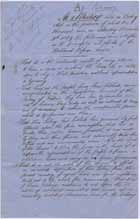The diggers who rushed to Victoria’s goldfields from 1851 are key players in the story of the development of democracy and responsible government in Victoria. This story is closely linked with the history of gold licences in Victoria. The hugely unpopular decision by Governor La Trobe in September 1851 to introduce a monthly licence fee sparked agitations on Victoria’s goldfields, which carried the echoes of international campaigns for democratic reform.
La Trobe’s proposed doubling of the licence fee from January 1852 was the catalyst for the Monster Meeting held at Forest Creek on 15 December 1851. This gathering is widely hailed as the beginning of the European diggers’ movement for political change. Other famous events are the meeting at Agitation Hill, Mount Alexander in May 1853, and the Red Ribbon Rebellion, centred around Bendigo later that year.
The most famous, and violent, demonstration of the miners’ struggle for reform of the goldfields and their administration is the uprising at Eureka on 3 December 1854. The battle at the Eureka Stockade is now widely hailed as a crucial event in the story of how democracy flourished in the young colony of Victoria, even the birthplace of Australian democracy itself. The historian Weston Bate describes Eureka’s aftermath as Victoria ‘taking democracy to the world’.
The introduction of the miner’s right in 1854 was a watershed for diggers, and for democracy – not only did this new licence (at 20 shillings annually) cost less than old hated monthly licences, it effectively gave diggers holding a miner’s right the right to vote. Male suffrage in Victoria was not achieved until 1857, however, when the property qualification for electors in the Legislative Assembly was finally removed.
The entries in this section discuss the historical events at Eureka, their aftermath and their legacy, from a variety of perspectives. International movements, like Chartism, which were a strong influence on Victorian diggers are explained. The little-known struggle of Chinese miners against the poll tax is also discussed.
In this section, you can also explore the rich cultural heritage from the Victorian goldfields in the early 1850s. The most iconic objects from this period are the Ballarat Reform League Charter and the Eureka Flag.





